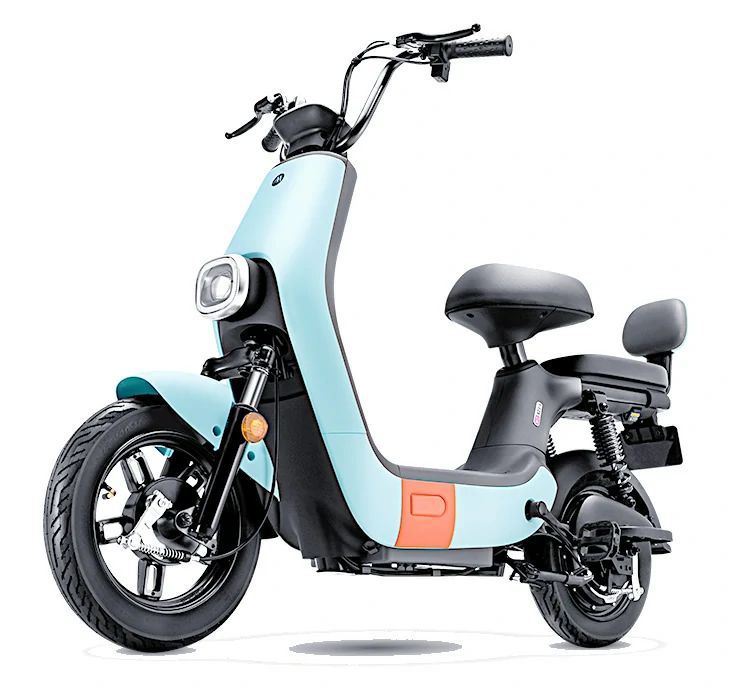48 volt electric bicycle range test data
2025-05-29
1、 Core Data: Laboratory vs Real Scene
- Standard test data
- Laboratory conditions (25 ℃ constant temperature, 50kg load, 15km/h constant speed):
- 48V12Ah battery: theoretical range of about 36-48 kilometers.
- 48V20Ah battery: theoretical range of about 60-80 kilometers (some brands claim up to 80 kilometers).
- Actual road condition test:
- The 48V20Ah battery has a range of about 55-60 kilometers in summer and drops to 30-35 kilometers in winter (5 ℃).
- Typical case: Yadi 48V20Ah model, tested at 25 ℃ for 58 kilometers, reduced to 32 kilometers in winter (minus 3 ℃).
- Laboratory conditions (25 ℃ constant temperature, 50kg load, 15km/h constant speed):
- User test cases
- Violent cycling test: After upgrading the Super Micro Black Gold Graphene battery (23Ah), a user maintained a daily load capacity and frequent rapid acceleration, and still maintained a range of 70 kilometers in spring and summer seasons.
- Takeout scenario: The 72V38Ah battery can carry 90 kilograms in summer and run for 138 kilometers, while in winter, it can last for 90 kilometers in heavy snow in Hangzhou.
Special technology vehicle models
- Sodium battery models (such as Taiwan Bell 48V20Ah): claim a range of over 100 kilometers and excellent low-temperature performance (-10 ℃ capacity decay<8%).
Graphene battery model: A certain brand's 23Ah battery has a load capacity of 75 kilograms, a range of 65 kilometers at 30km/h, and a remaining 8% battery capacity.

2、 Five key factors affecting battery life
- Battery capacity and type
- Capacity: The theoretical endurance of a 20Ah battery is twice that of a 10Ah battery, but it is actually affected by discharge efficiency (lithium battery discharge efficiency>95%, lead-acid battery about 90%).
- Type:
- Lithium batteries have an energy density 2-3 times that of lead-acid batteries, longer battery life, and reduced low-temperature decay.
- Sodium batteries have an energy density similar to lithium batteries, but with lower cost and excellent low-temperature performance.
- Cycling conditions
- Speed: 25km/h saves 40% energy compared to 40km/h.
- Load capacity: The load capacity increases by 100 pounds, and the endurance decreases by about 20%.
- Road conditions: Frequent starting and stopping (such as congested roads) or climbing can significantly increase energy consumption.
- environmental factor
- Temperature: Low temperatures (such as minus 10 ℃) cause a 50% decrease in the capacity of lead-acid batteries and an 8% decrease in the capacity of lithium batteries.
- Tire pressure: When it is insufficient, rolling resistance increases and energy consumption increases by 10%.
- Wind speed: Riding against the wind increases energy consumption by 15-20%.
- Vehicle maintenance
- Battery maintenance: Regular deep discharge (once a month), avoiding overcharging and overdischarging, can extend battery life.
- Mechanical state: Tight brakes and lack of oil in bearings will increase resistance and shorten endurance.
- Motor and controller efficiency
- Motor efficiency: The efficiency of the square wave controller is about 85%, and the sine wave controller can reach 92%.
- Controller algorithm: The intelligent BMS can optimize the discharge strategy and improve the battery life by 5-10%.
3、 Practical skills for improving battery life
- Optimization of driving habits
- Cycling at a constant speed: Maintain an economical speed of 20-25km/h and avoid sudden acceleration/braking.
- Utilizing kinetic energy recovery: Release the switch when going downhill or decelerating, and some models can recover 5-10% of their battery life.
- Vehicle Maintenance Checklist
- Monthly check tire pressure: maintain 2.5-3.0 Bar, and replenish air promptly when the pressure is insufficient.
- Cleaning battery contact points: Wipe with alcohol swabs to avoid poor contact caused by oxidation.
- Lubricate the chain: Apply chain oil every 500 kilometers to reduce transmission losses.
- Battery management strategy
- Charging timing: Charge when the battery is 30% low to avoid overdischarging (voltage<10.5V).
- Winter storage: Keep 50% battery capacity and avoid low-temperature storage (<0 ℃).
- Fast charging usage: no more than 5 times per month, after fast charging, let it sit for 30 minutes before cycling.
4、 Selection suggestion: Choose batteries according to your needs
- Daily commuting (less than 15 kilometers per day)
- 48V12Ah lead-acid battery is sufficient, with low cost and simple maintenance.
- Recommended car models: Yadea Ouyi, Aima Little Honey Bean.
- Long distance demand (daily average>30 kilometers)
- Priority should be given to models with 48V20Ah or above lithium or sodium batteries.
- Recommended models: C90 No. 9 (48V25Ah lithium battery), Tailing Super Energy S (48V20Ah sodium battery).
- Special Scene
- Northern users: choose sodium batteries or low-temperature resistant lithium batteries (such as Xingheng lithium batteries).
- Delivery rider: Choose graphene batteries of 72V38Ah or above, supporting fast charging.
5、 Summary: Range=Hardware x Habits x Environment
The range of a 48 volt electric bicycle is the comprehensive result of multiple factors such as battery capacity, riding habits, and environmental temperature. By optimizing driving behavior (such as riding at a constant speed and avoiding sudden braking), strengthening vehicle maintenance (such as checking tire pressure and cleaning batteries), and managing batteries reasonably (such as avoiding over discharge and winter insulation), users can significantly improve their actual range. When making a purchase, it is necessary to consider one's own needs, prioritize battery type and capacity, and pay attention to special technologies (such as sodium batteries and graphene batteries) to obtain a better experience.
